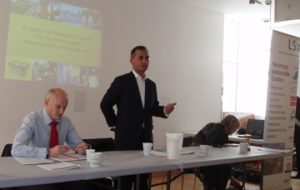London Mayor’s air quality data questioned
London Assembly member Murad Qureshi suggests government statistics on PM2.5 deaths in London ‘do not tally’ with London Mayor’s claims of reduction in pollutant
The London Mayor’s figures on particulate matter PM2.5 levels in the capital ‘do not tally’ with data published by the government last week, according to London Assembly Member Murad Qureshi.
A progress report on the Mayor’s air quality strategy was published in July 2013, showing that nitrogen oxide emissions have reduced by 20% and PM2.5 emissions by 15% since Mr Johnson’s election in 2008 (see airqualitynews.com story).
However, information published by the government last week showed that the percentage of deaths attributable to air pollution increased in 15 of 33 London boroughs in 2011 (see airqualitynews.com story).
And, speaking in his personal capacity at an air quality conference yesterday (November 14), Mr Qureshi said: “The data released from the Department for Health is revealing and it does show that things are getting worse rather than better, and this is contrary to what the Mayor’s office is saying.”
Mr Qureshi, who also chairs the Assembly’s environment committee, added: “The interesting thing is that these total deaths attributable to PM2.5 do not tally with the figures we are getting from the Mayor of London’s office City Hall. He is using computer modelling to say that there was a 15% reduction of PM2.5 since 2008. So there is a discrepancy between the figures.”
His comments came at the Cleaner Air 4 Communities conference and workshop in London yesterday (November 14), which was organised by the charity London Sustainability Exchange (LSX).
The aim of the conference was to look at how local residents and volunteers across London can tackle air pollution and the charity outlined a number of recommended actions, such as car idling enforcement, ecodriving training for taxi drivers and business engagement programmes.
Low emission zone
Speaking at the event, Mr Qureshi also gave his views on Mayor Boris Johnson’s plans to introduce an ultra-low emission zone in central London by 2020, which could potentially see only zero or low emission vehicles driving in central London during working hours.
Commenting on the lack of clarity over which types of cars and how many the zone would impact on, he said: “Quite honestly, policy has got into a major muddle because it is not clear what vehicles it will be applicable to.”
He also called for the zone to be introduced before 2020, suggesting that it “could be much more effective if it was built up sooner rather than later”.
“Quite frankly it is kicking the problem further into the long term. The Mayor is standing down in 2016 — he has not indicated that he plans to fight another election.
“And as for manufacturers being given notice well I would suggest that the industry is much more prepared than we realise. They are probably much more able to respond earlier then 2020.”
Diesel filters
Furthermore, Mr Qureshi called for action from agencies and Trading Standards to tackle the removal of diesel particulate filters on cars.
He said: “There has been a worrying trend with the dash to diesel and the removal of the dust filters in those cars. And it is a serious threat to air pollution in London particularly regarding PM10s. Thankfully there has been guidance from the Department for Transport (DfT) that removing these filters should be illegal, but there needs to be more of an informed debate that we have with these diesel car owners.”
Also speaking at the conference was Christopher Snelling, head of urban logistics at the Freight Transport Association (FTA), who said that tackling traffic emissions made business sense in the logistics industry “because every bit of fuel we use costs us hugely”.
Additionally, Mr Snelling called for better refuelling infrastructure for petrol-alternative vehicles and for HGV users to be allowed to drive more frequently at night when roads are quieter.
But, he said: “The single thing we can so to improve emissions is to reduce congestion. If you don’t stop you use 28 litres of fuel on certain stretches of road but that goes on to 48 if you even stop just twice. Anything that reduces congestion is good for us and promoting cycling can free up road space.”
















